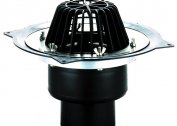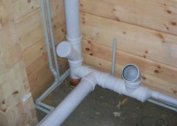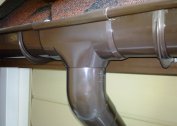Incorrectly calculated depth of the sewer pipes leads to unpleasant consequences. At the most unexpected moment, drains from sinks, toilets and bathtubs cease to merge. Often such a nuisance happens in winter, when repair and excavation work is more difficult to carry out.
Why the depth of laying is important and why the mistakes are dangerous
The pipe is buried too shallow
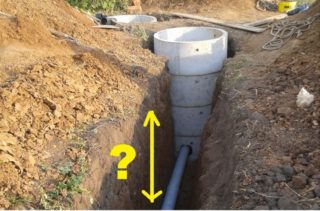 Fast flowing warm drains cannot freeze even in severe frosts. However, some of the effluent may remain at the bottom of the pipe. If the pipe is buried shallow, in severe frosts, these residues freeze. At the next discharge of warm water from the bath, they can be melted and washed away. But if the drain is small and cold (from the toilet or sink), a layer of ice can grow even more. So a few times the mouth of the pipe can become completely clogged with ice.
Fast flowing warm drains cannot freeze even in severe frosts. However, some of the effluent may remain at the bottom of the pipe. If the pipe is buried shallow, in severe frosts, these residues freeze. At the next discharge of warm water from the bath, they can be melted and washed away. But if the drain is small and cold (from the toilet or sink), a layer of ice can grow even more. So a few times the mouth of the pipe can become completely clogged with ice.
Incorrectly calculated slope
With a slight slope of the pipe towards the septic tank, the water stagnates, disappears badly even in summer. In winter, this stagnant water can also freeze and block the flow at all.
The pipe is buried too deep
Its end enters the lower part of the septic tank, and this worsens the discharge by gravity. The level of sewage in the septic tank will always be above the pipe. In this case, the effluents will leave the house, but weakly, according to the law of communicating vessels, and not by an active one-time discharge. And this can lead to stagnation of sewage in the pipe, the deposition of solid organics clogging the drain. In winter, runoff in such a system can also freeze.
The pipe is laid in an arc, humping up or down
In both cases, the flow will be difficult, the water will stagnate, mud deposits will accumulate, and in winter the system may freeze. An unpleasant odor can enter the house from all siphons.
Depth of laying according to SNiP
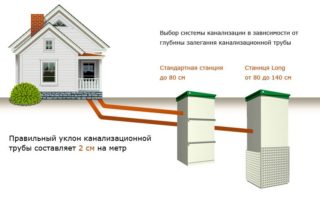 The norms of SNiP indicate the depth of gravity sewage for individual houses. It is different for different climatic zones. For the climate near Moscow and Sochi, these indicators are different. This is connected, of course, in order to avoid freezing of effluents. You can understand what SNiP recommends on this topic from the norms common to all climatic zones. Namely:
The norms of SNiP indicate the depth of gravity sewage for individual houses. It is different for different climatic zones. For the climate near Moscow and Sochi, these indicators are different. This is connected, of course, in order to avoid freezing of effluents. You can understand what SNiP recommends on this topic from the norms common to all climatic zones. Namely:
The depth of laying sewer pipes at the exit from the building should be 30 cm higher than the average annual freezing point.
But in any climate, no less than 70 cm.
In reality, it is impossible to take into account the depth of freezing. In most climatic zones north of Voronezh, it reaches 2 m. Therefore, according to SNiP, the pipe at the exit from the house should be at a depth of 200 cm - 30 m = 170 cm.
The depth of 1 m 70 cm is not justified and excessive even in the northern regions. In addition, it should be noted that at the other end, because of the slope, the pipe will be even lower.
Optimal depth
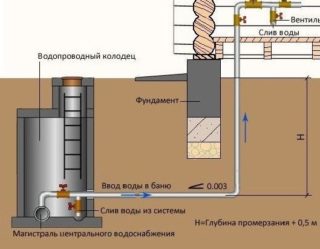 In practice, the most common depth of a sewer pipe at the exit of a building is from 50 cm in the south to 100 cm in the northern regions. The following factors can affect the depth of a hole:
In practice, the most common depth of a sewer pipe at the exit of a building is from 50 cm in the south to 100 cm in the northern regions. The following factors can affect the depth of a hole:
- The pipe passes under the road, then it is buried as deep as possible.
- The building has a shallow foundation. During the construction, a hole was not provided for the outlet of the pipe. Then the pipe is laid below the foundation, so as not to hammer a hole in the concrete.
- On the site, uneven terrain with steep elevations. It may turn out that the depth of laying in different places will be very different. The slope of the pipe will have to be made steep.
- For some reason, the capacity of the septic tank is set shallow, then they try to lay the pipe as high as possible.
The depth of the septic tank capacity is determined individually for each site, taking into account local conditions. The factor of freezing of effluents in the tank itself is not taken into account. the following reasons:
- Factory septic tanks are usually about 2 m high.The earth at this depth retains heat throughout the cold season (for this reason, it is warm in the cellars and basements in winter).
- Wastewater regularly flows into the septic tank.
- The biodegradation reactions of organics in effluents produce additional heat.
In severe frosts in the northern regions, a septic tank buried in the ground can be insulated from above with snow or any insulation used in construction.
Depth calculation
 Before calculating the depth at the exit from the building, it is necessary to provide what depth will be at the entrance to the septic tank. To do this, you need to know the slope standards for 1 m and the length of the entire pipeline. The basic reference for such calculations is 2 cm slope per 1 m of length. If the septic tank is located 10 m from the building, the height difference of the pipe at the outlet of the building and at the entrance of the septic tank should be 20 cm
Before calculating the depth at the exit from the building, it is necessary to provide what depth will be at the entrance to the septic tank. To do this, you need to know the slope standards for 1 m and the length of the entire pipeline. The basic reference for such calculations is 2 cm slope per 1 m of length. If the septic tank is located 10 m from the building, the height difference of the pipe at the outlet of the building and at the entrance of the septic tank should be 20 cm
The basic standard can be adjusted depending on the diameter of the pipe. The larger the diameter of the pipe, the smaller the slope can be. Conversely, for a thin pipe, a larger slope is needed.
Specific indicators:
- Pipe D50 - slope per 1 m of length 3 cm.
- D100-110 - 2 cm slope.
- D160 - 1 cm slope.
- D200 - a slope of 0.7 cm.
According to this simple scheme, it is easy to calculate a sufficient bias for the average house in which a family of 3-7 people lives. For buildings with a large number of plumbing fixtures (several bathtubs, toilets, etc.), it will be necessary to calculate the diameter of the pipes and the slope according to the formula V = H / d ≥ K, where:
- V is the flow rate;
- H - occupancy;
- d is the pipe diameter;
- K is the coefficient adopted for each type of pipe.
In such cases, sewers are made according to projects prepared by specialists. Sewerage installation in such buildings is carried out by skilled workers under the supervision of a foreman or site manager. To determine the slope when digging a trench, a level is used.
When installing the sewage system on your own, the slope is controlled by one of the following methods:
- According to the marks of the level.
- On the cord stretched without sagging.
It is pulled strictly horizontally, controlled by the usual building level or hydraulic level. The distance from the cord to the bottom of the trench is measured with a tape measure every meter, achieving the desired height difference for each meter.
Instead of the cord, metal profiles (corner, square) 4-6 m long can be used. The profile is laid at the bottom of the trench. A level is placed on the profile, it is aligned horizontally, and the distance to the bottom of the trench is measured.
Calculation example
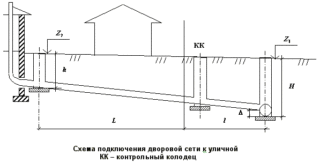 A pipe with a diameter of 100 mm is laid. A slope of 2 cm per 1 m is required. In this case, one end of the control 4 meter profile should lie on the ground near the building. The second end, set under the level, should be 8 cm (4m by 2 cm) from the bottom of the trench. If the distance is less, the bottom of the trench is dug. If more - add sand.
A pipe with a diameter of 100 mm is laid. A slope of 2 cm per 1 m is required. In this case, one end of the control 4 meter profile should lie on the ground near the building. The second end, set under the level, should be 8 cm (4m by 2 cm) from the bottom of the trench. If the distance is less, the bottom of the trench is dug. If more - add sand.
Then the profile is transferred further, and according to the same scheme, the slope is continued to align to the septic tank itself.
It is advisable to spill the bottom of the trench under the pipe with sand along the entire length. Then the pipe will lie tight, without sagging. Pressure from the topsoil will be evenly distributed. The pipe will not burst due to pressure from above, which can happen if there is emptiness under it, and the load from above is significant. For example, a truck or a dump truck will drop into the area.
Sometimes for various reasons it is not possible to bury the sewer even 30-50 cm. This may be:
- on rocky soils
- in steep slopes where the pipe exits in places
- when crossing the pipe with communications (gas pipes, high-voltage cable).
Then the pipe is buried as far as possible, and two methods of protection are used against freezing (one of them or two together):
- The pipe is insulated from above with a material with good heat-insulating properties that are not lost from soil moisture (slag, minplite, expanded clay, polystyrene).
- A heating cable is pulled in parallel with the pipe. If in frost there is a suspicion of freezing of the pipe, the cable is turned on and the ice melts.
In addition to the laying depth and insulation, the material itself from which the pipes are made also affects the resistance to freezing.Metal and ceramics do not hold heat well and freeze faster than plastic pipes made of PPN, PND and PVC.
The thicker the wall of the plastic pipe, the less likely it is to freeze. The possibility of freezing is also reduced if in severe frosts the pipe is covered with a thick layer of snow from above.
The most optimal option for sewage is a one-piece plastic pipe without joints. It does not rust, does not require unnecessary work to seal joints, smooth along its entire length and less prone to blockages, designed for a long service life. Such pipes are sold both in bays and in segments of the desired length.
